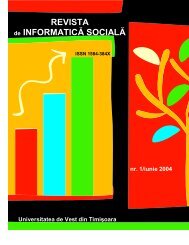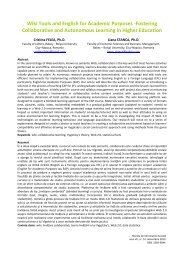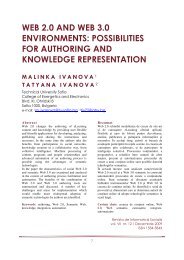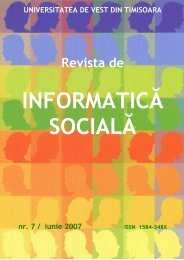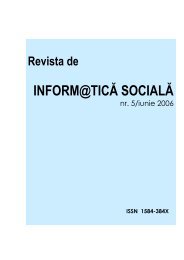No 14 - Journal of Social Informatics / Revista de Informatica Sociala
No 14 - Journal of Social Informatics / Revista de Informatica Sociala
No 14 - Journal of Social Informatics / Revista de Informatica Sociala
You also want an ePaper? Increase the reach of your titles
YUMPU automatically turns print PDFs into web optimized ePapers that Google loves.
Overall, we can therefore sum up one <strong>of</strong> the main evi<strong>de</strong>nce coming out from our research by sayingthat in the media diet <strong>of</strong> our university stu<strong>de</strong>nts, the Internet is by far the most preferred media,followed (at a certain distance) by the television, while the radio has a residual place. At a nationallevel, consi<strong>de</strong>ring the whole Italian population, the opposite seems to hold: the television is in factthe most preferred media, followed by the radio and by the Internet. Reading book is an activity thatconcerns only a minority <strong>of</strong> the overall population; even if the propensity to read book seems to beslightly above the national average in our sample, still it has to be consi<strong>de</strong>red that the majority <strong>of</strong>our sample <strong>of</strong> university stu<strong>de</strong>nts doesn’t read any book at all, or reads no more than five books in ayear.As already said, a significant part <strong>of</strong> our questionnaire was also focused on the diffusion and use <strong>of</strong>tools <strong>of</strong> the so-called social web, or web 2.0: blog, social network sites, and communities. Data onthe diffusion <strong>of</strong> blogs seem to provi<strong>de</strong> a kind <strong>of</strong> mixed evi<strong>de</strong>nce, and overall the phenomenon surely<strong>de</strong>serves additional investigations. First <strong>of</strong> all, there is a slight <strong>de</strong>crease in the percentage <strong>of</strong> subjectswho positively answer to the question “Do you have your own blog?”, that goes from 42.2% <strong>of</strong> thesample in 2008 to 35.7% in 2009. On the other si<strong>de</strong>, it is interesting to look specifically at theintensity <strong>of</strong> substantial involvement in blogging, that could be assessed by consi<strong>de</strong>ring thefrequency with which the blog itself is updated; the percentage <strong>of</strong> respon<strong>de</strong>nts who say they neverupdate their blog increases, from 28.2% in 2008 to 43.3% in 2009, while at the same time there is aslight increase in the percentage <strong>of</strong> regular bloggers, who update their blog every day (from 5.2% to8,2%). Obviously, we cannot extrapolate any long term trend as we got only two years <strong>of</strong>observations, but we can postulate that a number <strong>of</strong> subjects are shifting from the use <strong>of</strong> blogs to theuse <strong>of</strong> some kind <strong>of</strong> social networks (in particular, in the case <strong>of</strong> our sample, to Facebook, as wewill see); this might contribute to explain why the number <strong>of</strong> bloggers is diminishing, while at thesame time the number <strong>of</strong> regular bloggers is raising.The activity <strong>of</strong> reading other people’s blogs seem to be <strong>de</strong>clining as well: in 2008, stu<strong>de</strong>nts whoreported reading others’ blogs were in fact almost 8 out <strong>of</strong> 10, while in 2009 this number dropsdown to less than two out <strong>of</strong> three. The percentage <strong>of</strong> those who read other people’s blogs every dayremains substantially unchanged, while there is an increase in the number <strong>of</strong> those who read theblog “a few times a month” and a corresponding <strong>de</strong>crease in the number <strong>of</strong> those who read the blog“a few times a week”. The majority <strong>of</strong> our sample (55.1%) do not post comment on others’ blogs,and there is only a small percentage <strong>of</strong> subjects who <strong>de</strong>clare to post comments on a regular basis.One <strong>of</strong> the most significant trends that clearly comes out <strong>of</strong> our data concerns, in any case, what wecan label as a real “Facebook phenomenon”. It is worth remembering that the boom <strong>of</strong> popularity <strong>of</strong>Facebook in Italy substantially started in the summer <strong>of</strong> 2008. According to data provi<strong>de</strong>d byComScore, in the month <strong>of</strong> August 2008 there were over one million and three hundred thousandvisits to this site, with an annual increase <strong>of</strong> 961%, while the third quarter <strong>of</strong> 2008 saw Italy headingthe list <strong>of</strong> countries with the largest increase in the number <strong>of</strong> users (+135%).The evolution <strong>of</strong> the phenomenon can be followed thanks also to the Facebook Observatory(http://www.vincos.it/osservatorio-facebook/), according to which the Italian members <strong>of</strong> Facebookwere 216.000 in January 2008, 622.000 in August, 1 million and 294 thousand in September and upto 5.587.000 in December 2008. Also our data clearly confirm a radical increase in the number <strong>of</strong>subjects who have a Facebook account, that goes from 7.9% in 2008 to 59.4% in 2009; at the sametime, the percentage <strong>of</strong> those who even don’t know about Facebook at all drops down from 50.4%to 2.2% (Figure 4). It seems that Facebook is mostly used in or<strong>de</strong>r to meet new friends, as the37.2% <strong>of</strong> our sample reports this as the main motivation for opening an account on this site. The15.8% <strong>of</strong> our sample uses this site for general entertainment purposes, while the 9.5% uses it mainlyas an instant messaging tool.




